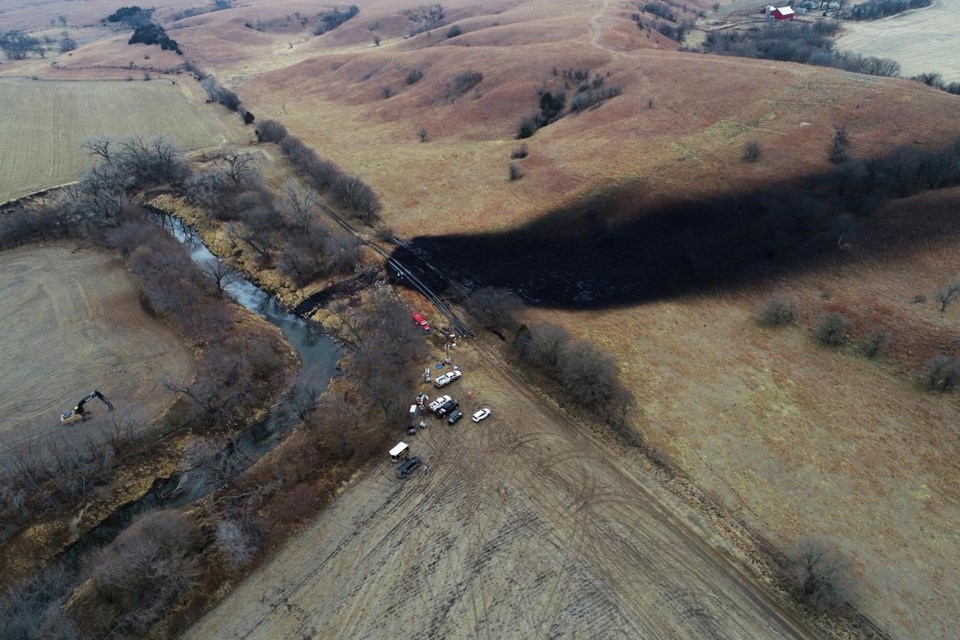TOPEKA, Kan. (AP) — U.S. government regulators have stopped allowing a large part of the Keystone oil pipeline to operate at higher-than-normal pressures following in northeastern Kansas in December.
The order this week from the U.S. Department of Transportation's pipeline safety arm covers 1,220 miles (1,963 kilometers) of the Keystone pipeline in seven U.S. states. Regulators already had ordered the system's operator, Canada-based TC Energy, to reduce the pressure on a 96-mile (155-kilometer) segment of the pipeline from southern Nebraska near the Kansas border into central Kansas, where the spill occurred.
The regulators' action came ahead of the first hearings in the Kansas Legislature on the spill. A TC Energy official is set to face questions from lawmakers Tuesday during a joint meeting of two House committees.
TC Energy said in a statement Friday that it was already operating within the pressure limits set by this week's order and that it would continue to comply.
“Our commitment to the safe operations of our system is unwavering,” the company said.
But Zack Pistora, a lobbyist in Kansas for the Sierra Club, said Friday that perhaps regulators should reconsider the Keystone pipeline’s operation “in its entirety.” The system has had more than 20 spills since it began operations in 2010, and the one in Kansas was the system's largest and the largest U.S. onshore spill according to the regulators.
”There’s no confidence that this pipeline won’t be breaking again in the near future, even with less pressure," Pistora said.
The latest order from regulators directed TC Energy to lower the maximum pressure by 10% on the pipeline from North Dakota's border with Canada to northern Oklahoma, as well as the system's spur from southern Nebraska through Missouri into central Illinois. That would bring the maximum pressure into line with what's normally allowed after TC Energy had received a special permit to exceed it six years ago.
A pipeline rupture Dec. 7 dumped nearly 13,000 barrels — each with enough crude to fill a standard household bathtub — in a creek through rural pasture land in Washington County, Kansas, about 150 miles (240 kilometers) northwest of Kansas City.
No one was evacuated following the spill, and officials said it did not affect the two larger rivers and reservoir downstream from the affected creek. With regulators’ permission, the company a little more than three weeks after the spill.
However, in a separate Jan. 6 cleanup order, the U.S. Environmental Protection Agency said the amount of oil spilled was “a harmful quantity” violating the nation's clean water laws. The Associated Press obtained a copy of the EPA order through a Freedom of Information Act request.
TC Energy must notify the state and the EPA's on-site coordinator before shipping out any hazardous materials. Also, the company will pay the U.S. government's costs from the cleanup and faces a fine of nearly $52,000 a day if it violates the EPA order.
to Congress in July 2021 noted that pipeline regulators had allowed the higher-than-normal maximum pressure on the Keystone system starting in 2017. The regulators concluded the operating at the higher pressures was safe if TC Energy met more than 50 conditions.
TC Energy said last month that caused a crack that grew over time because of the stress on a bend in the pipeline where the rupture occurred. The company has estimated that the cleanup will cost $480 million, and it has an average of 800 people on site in any given 24-hour period.
“We continue to progress,” on the cleanup and investigating the root cause of the pipeline rupture, the company said in its statement.
The 2,700-mile (4,345-kilometer) Keystone system carries heavy crude oil extracted from tar sands in western Canada to the Gulf Coast and to central Illinois.
Concerns that spills could pollute waterways spurred opposition to plans by TC Energy to build another crude oil pipeline in the same system, the 1,200-mile (1,900-kilometer) Keystone XL, across Montana, South Dakota and Nebraska. President Joe Biden’s cancelation of a permit led the company to in 2021.
The pipeline regulators' order this week also requires TC Energy to review the pipeline pressure and consider potential problems each month on the 291-mile (468-kilometer) Keystone segment from southern Nebraska into northern Oklahoma.
The order said that not reducing the pressure on more of the pipeline and requiring other measures would make pipeline operations “hazardous to life, property or the environment.”
___
Follow John Hanna on Twitter:
John Hanna, The Associated Press



